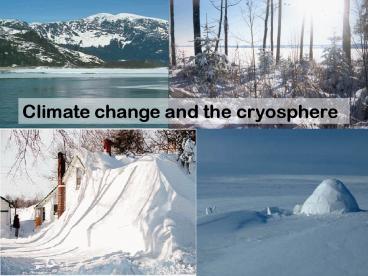Climate change and the cryosphere
Title: Climate change and the cryosphere
1
Climate change and the cryosphere
2
Outline
- Background, climatology variability
- Role of snow in the global climate system
- Contemporary observations of climate change
- Cryospheric indicators of climate change
- Future global regional projections
implications of climate change
3
Background, climatology variability
4
Surface water budget ?S P E R
5
20th Century Climatology
Observed
GFDL
Ref Masuda
6
Current snow coverage
30 March 2009
7
Departure from average
30 March 2009
8
Seasonal climatology
9
Observed GFDL Northern Hemisphere Snow Extent
(x106 km2), 1973-2000
Season OBS GFDL MAE RMSE
Winter 44 42 2.4 0.55
Spring 30 35 4.8 1.00
Summer 6 4 2.3 0.51
Fall 19 20 1.7 0.40
Annual 25 25 0.9 0.22
10
Mean annual maximum monthly snow mass (kg m-2) in
Canada, 1980-1997(Brown et al. 2003)
11
Current SWE in Prairies
12
Monthly Eurasian standardized snow cover extent
anomalies
13
Interannual variability
Source Karl et al. (1993).
14
Role of snow in the global climate system
15
Annual cycle of daily discharge in Skeena River
(1955-2004)
freshet
16
Variation of peak discharge with latitude for 42
Hudson Bay rivers
Source Déry et al. (2005), J. Climate.
17
Contribution of snow to river runoff
Source Barnett et al. (2005).
18
Teleconnections
Definition Atmospheric interactions between
widely separated regions that have been
identified through statistical correlations (in
space and time). For example, the El Niño
teleconnection with the Southwest United States
involves large-scale changes in climatic
conditions that are linked to increased winter
rainfall.
19
(No Transcript)
20
(No Transcript)
21
(No Transcript)
22
(No Transcript)
23
Correlation coefficient between annual Eurasian
snow extent anomalies discharge anomalies the
following year in 64 rivers of northern Canada
Source Déry et al. (2005), JGR.
24
Observed 20th century climate change
25
Warming air temperatures
Climatic Research Unit, University of East
Anglia, http//www.cru.uea.ac.uk/
26
20th century climate trends
Reference Déry and Wood (2005)
27
Trends in global surface air temperature
28
Trends in global surface precipitation
29
20th century temperature-precipitation
covariability
Reference Déry and Wood (2005)
30
Cryospheric indicators of global change
- Snow depth, swe, density, albedo temperature
(heat content) - Duration of snow cover growing season
- Snowmelt/spring freshet date
- Soil moisture
31
Snow depth
Source Curtis et al. (1998), Int. J. Climatology
32
(No Transcript)
33
Annual cycle of daily snow accumulation (SWE) at
Barkerville
34
(No Transcript)
35
Trend () in April 1st swe, 1950-1997
Source Mote et al. (2005), BAMS
36
Albedo
Source Stone et al. (2002), JGR.
37
Trend (days/year) in snow cover duration,
1972-2000
38
(No Transcript)
39
Snowmelt Date
Source Stone et al. (2002), JGR.
40
Annual cycle of daily runoff for the Swift River
near Barkerville
41
Trend in centre of volume in river discharge
across western N. America
Source Stewart et al. (2005), J. Climate.
42
Future projections implications of global change
43
Components of the climate system
44
IPCC 4th Assessment
45
IPCC 4th Assessment
46
Expected indicators of climate change
IPCC 3rd Assessment
47
IPCC 4th Assessment
48
IPCC 4th Assessment
49
IPCC 4th Assessment Runs
50
Trends in Northern Hemisphere snow cover extent
Source Déry et al. (2006), JGR.
51
Projected change in seasonal snow cover frequency
based on GFDL CM2 simulations (21st - 20th
century)
-0
Projected change in frequency
52
Trends in Northern Hemisphere snow mass
53
Projected change in seasonal snow water
equivalent (swe) based on GFDL CM2 simulations
(21st - 20th century)
-1
Projected change in swe (mm)
54
(No Transcript)
55
Regional climate (baseline)
- Source PCIC (http//www.pcic.uvic.ca)
56
Temperature Projections
57
Precipitation projections
58
Regional Projections for snow
59
Implications of global change
- Increase in planetary albedo (positive feedback
on global warming) - Decreasing water resources, including soil
moisture - Longer growing season
- Impacts on recreational activities
- Ecological implications
60
Further reading
61
Points of Discussion
- Which component of the cryosphere is most
vulnerable to climate change? - What are the possible environmental impacts of
climate change in Prince George, B.C., Canada? - Will there be any jobs for cryospheric scientists
in the 21st century?
62
(No Transcript)































